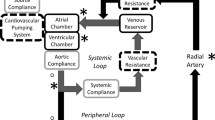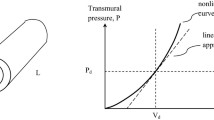Abstract
Despite its undisputed utility for determining changes in ventricular pressure-volume relationships, the conductance catheter technique has not been proven reliable for measuring absolute volume. This limitation is due to violations of the assumptions inherent in the cylindrical model on which the method is based (i.e., homogeneous electric field and no leakage current). The purpose of this investigation was to relate cylindrical model correction factors to the physical environment of the catheter and to the cylindrical equation. Physical measurements of saline-filled, nonconductive cylinders using a four-electrode conductance catheter were compared with a three-dimensional finite element model of the physical apparatus. These measurements were incorporated into a parallel conductance model to relate physical parameters to corrections in the cylindrical equation for volume measurement. Excellent agreement between measured and modeled data was found. Results demonstrated a nonlinear relationship between the field nonhomogeneity correction factor (α) and cylinder diameter. The relationship between α and diameter was consistent with a theoretical extrapolation of cylinder diameter toward infinity. An inverse relationship between α and the parallel conductance volume (V P) was also clarified. The parallel conductance model was able to demonstrate opposite effects of the physical presence of the catheter body and electrodes, which tended to cancel out any net effect on measured conductance. Results of this investigation and the developed finite element model clarify the nature of the correction terms in the cylindrical model and may lead to greater application of the conductance technique.
Similar content being viewed by others
References
Applegate, R.J., C.P. Cheng, and W.C. Little. Simultaneous conductance catheter and dimension assessment of left ventricle volume in the intact animal.Circulation 81: 638–648, 1990.
Baan, J., E. T. Van Der Velde, H. G. De Bruin, G. J. Smeenk, J. Koops, A. D. Van Duk, D. Temmerman, J. Senden, and B. Buis. Continuous measurement of left ventricular volume in animals and humans by conductance catheter.Circulation 70:812–823, 1984.
Boltwood, C. M., {jrJr.}, R. F. Appleyard, and S. A. Glantz. Left ventricular volume measurement by conductance catheter in intact dogs. Parallel conductance volume depends on left ventricular size.Circulation 80:1360–1377, 1989.
Burkhoff, D., E. Ven Der Velde, D. Kass, J. Baan, W. L. Maughan, and K. Sagawa. Accuracy of volume measurement by conductance catheter in isolated, ejecting canine hearts.Circulation 72:440–447, 1985.
Dickstein, M. L., O. Yano, H. M. Spotnitz, and D. Burkhoff. Assessment of right ventricular contractile state with the conductance catheter technique in the pig.Cardiovasc. Res. 29:820–826, 1995.
Ferguson, J. J., {jrIII}, M. J. Miller, P. Sahagian, J. M. Aroesty, and R. G. McKay. Assessment of aortic pressure-volume relationships with an impedance catheter.Cathet. Cardiovasc. Diagn. 15:27–36, 1988.
Ferguson, J. J. {jrIII}, M. J. Miller, P. Sahagian, J. M. Aroesty, and R. G. McKay. Effects of respiration and vasodilation on venous volume in animals and man, as measured with an impedance catheter.Cathet. Cardiovasc. Diagn. 16:25–34, 1989.
Gawne, T. J., K. S. Gray, and R. E. Goldstein, Estimating left ventricular offset volume using dual-frequency conductance catheters.J. Appl. Physiol. 63:872–876, 1987.
Heringa, A., D. F. Stegeman, G. J. H. Uijen, and J. P. C. De Weerd. Solution methods of electrical field problems in physiology.IEEE Trans. Biomed. Eng. BME-29:34–42, 1982.
Lankford, E. B., D. A. Kass, W. L. Maughan, and A. A. Shoukas. Does volume catheter parallel conductance vary during a cardiac cycle?Am. J. Physiol. 258:H1933-H1942, 1990.
Miller, M. J., R. G. McKay, J. J. Ferguson, P. Sahagian, S. Nakao, P. C. Come, and W. Grossman. Right atrial pressure-volume relationships in tricuspid regurgitation.Circulation 73:799–808, 1986.
Mur, G., and J. Baan. Computation of the input impedances of a catheter for cardiac volumetry.IEEE Trans. Biomed. Eng. BME-31:448–453, 1984.
Plonsey, R., and D. G. Fleming. Bioelectric Phenomena. New York: McGraw-Hill, 1969, 380 pp.
Salo, R. W. The theoretical basis of a computational model for the determination of volume by impedance.Automedica 11:299–310, 1989.
Salo, R. W., T. G. Wallner, and B. D. Pederson, Measurement of ventricular volume by intracardiac impedance: theoretical and empirical approaches.IEEE Trans. Biomed. Eng. BME-33:189–195, 1986.
Sepulveda, N. G. Electric Field Distribution in Three Dimensional Regions Using the Finite Element: Method. New Orleans: Tulane University, Ph.D. Dissertation, 1984.
Spinelli, J. C., and M. E. Valentinuzzi. Conductivity and geometrical factors affecting volume measurements with an impedancimetric catheter.Med. Biol. Eng. Comput. 24:460–464, 1986.
Stamato, T. M. R.s. Szwarc, and L. N. Benson. Measurement of right ventricular volume by conductance catheter in closed-chest pigs.Am. J. Physiol. 269:H869-H876, 1995.
Steendijk, P., E. T. van der Velde, and J. Baan. Left ventricular stroke volume by single and dual excitation of conductance catheter in dogs.Am. J. Physiol. 264:H2198-H2207, 1993.
Steendijk, P., E. T. van der Velde, and J. Baan. single and dual excitation of the conductance-volume catheter analysed in a spherioidal mathematical model of the canine left ventricle.Eur. Heart J. 13:28–34, 1992.
Szwarc, R. S., D. Laurent, P.R. Allegrini, and H. A. Ball. Conductance catheter measurement of left ventricular volume: evidence for nonlinearity within cardiac cycle.Am. J. Physiol. 268:H1490-H1498, 1995.
Szwarc, R. S., L. L. Mickleborough, S.-I. Mizuno, G. J. Wilson, P. Liu, and S. Mohamed. Conductance catheter measurements of left ventricular volume in the intact dog: parallel conductance is independent of left ventricular size.Cardiovasc. Res. 28:252–258, 1994.
Woodard, J. C., C. D. Bertram, and B. S. Gow. Effect of radial position on volume measurements using the conductance catheter.Med. Biol. Eng. Comput. 27:25–32, 1989.
Author information
Authors and Affiliations
Rights and permissions
About this article
Cite this article
Hettrick, D.A., Battocletti, J.H., Ackmann, J.J. et al. Effects of physical parameters on the cylindrical model for volume measurement by conductance. Ann Biomed Eng 25, 126–134 (1997). https://doi.org/10.1007/BF02738544
Received:
Revised:
Accepted:
Issue Date:
DOI: https://doi.org/10.1007/BF02738544




